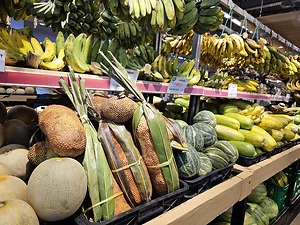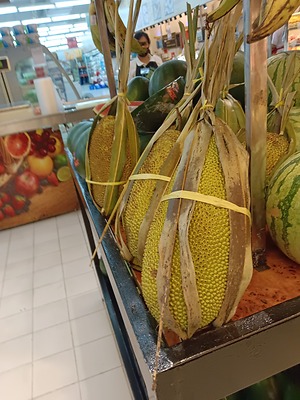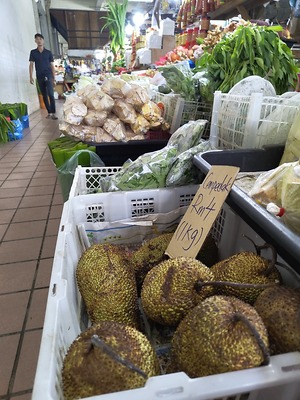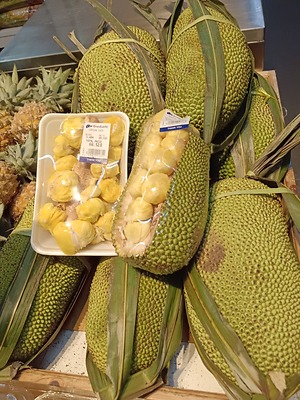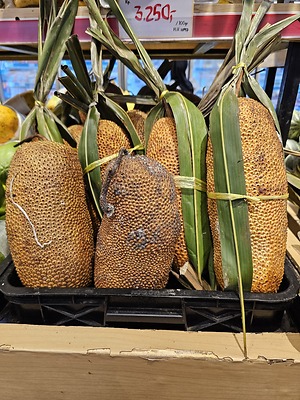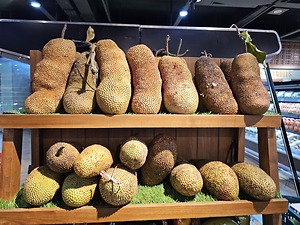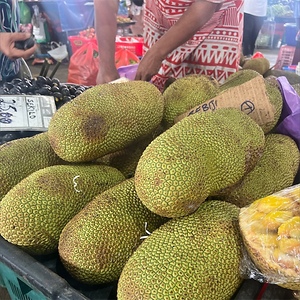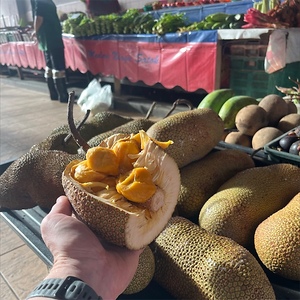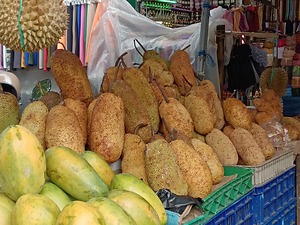

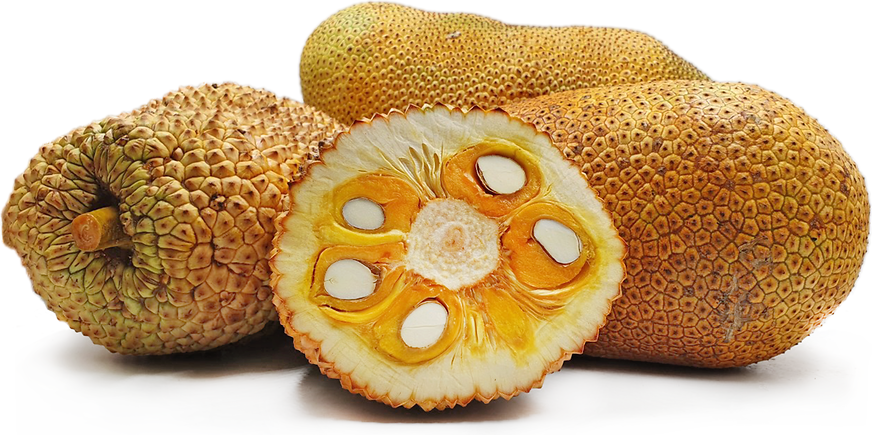
Cempedak
Estimated Inventory, lb : 0
Description/Taste
Cempedaks are tropical fruits known for their pungent aroma and rich flavor. They are between 25 and 45 centimeters long and 10 to 15 centimeters wide. They weigh about 1 to 6 kilograms. They have an elongated, somewhat irregular oval shape with several bumps along their body. Cempedaks have green skin that transitions to yellow-orange when ripe. This skin is segmented into small hexagons with small, fleshy spines on them. The bumpy skin is rough and spiky, becoming slightly more pliable as it ripens, while still maintaining a firm, fibrous texture. Cempedak flesh is segmented into an outer and inner portion. The outer flesh is a thin, edible membrane with a light yellow hue. It surrounds multiple large white seeds that are about 30 to 45 millimeters long. This flesh has a smooth, velvety, custard-like texture that becomes increasingly softer as the fruit ripens. Cempedaks have a distinct aroma that smells sweet, musky, and slightly fermented, with notes of honey, syrup, banana, and pineapple. Their flavor likewise resembles jackfruit, bananas, and pineapple, with notes of sweet nectar, mango, and durian.
Seasons/Availability
Cempedak is available in the summer in Southeast Asia, from late summer to autumn in Australia, and from fall to early winter in Singapore.
Current Facts
Cempedaks are botanically classified as Artocarpus integer and belong to the Moraceae family, which also includes figs, breadfruit, mulberries, banyan, and jackfruit. They are especially similar to jackfruit, sharing a similar appearance, common culinary uses, and prevalence in Southeast Asia. Cempedak trees are evergreen and can grow about 18 to 20 meters tall. Their bark is used for many purposes, including to make rope, latex, furniture, boats, cabinets, and dye. Cempedak fruits go by many different names depending on the region. They are referred to as Chempedak and Small Jackfruit in English, Sonekadat in Burmese, Kathar and Kalal in Hindi, Baroh and Campada in Indonesian, and Mit to Nu in Vietnamese. In Malaysia, two common varieties of Cempedak are Kapa, known for their sweet, fleshy, and crisp texture, and Barka, which are more sour.
Nutritional Value
Cempedaks provide the body with B vitamins like thiamine, riboflavin, and niacin, which are vital for energy metabolism, nerve function, and overall cellular health. Additionally, cempedak is a good source of vitamin C, an antioxidant that helps protect the body from free radical damage, supports immune function, and promotes healthy skin by aiding collagen synthesis. The fruit is also packed with carotenoids, including beta-carotene, which the body converts into vitamin A. This nutrient is crucial for maintaining good vision, skin health, and a strong immune system. Furthermore, cempedak is high in dietary fiber, which enhances digestive health by promoting regular bowel movements, helps manage blood sugar levels, and supports cardiovascular health by aiding in cholesterol regulation.
Applications
Cempedaks can be used in both their underripe and ripened state. The flesh can be puréed, seeds and all, and used in coconut ice cream, transformed into truffles, and dipped in chocolate. To make Cempedak truffles, blend the pureed flesh with condensed coconut milk and chocolate, gently simmer for five minutes, pour into chocolate shells, and let cool. Chocolate-dipped Cempedak can be made by puréeing the fruit into molds, freezing, and dipping them in chocolate. This fruit can also be preserved in syrup and canned. For a more savory offering add unripe segments to soups or dip them whole into batter and fry. Cempedak seeds can be milled into bread flour, roasted, or boiled in salt, the last of which results in a creation similar to a water chestnut. They can also be fried in their thin seed coats. In Banjar, Indonesia, the skin is fermented in brine, seasoned, fried, and used as a meat substitute. To use the Cempedak, deeply score the fruit from end to end. Use your fingers to pull off and rip open the skin. Once the interior of the fruit is fully exposed, lift out the segments and, if necessary or desired, remove the seeds.
Ethnic/Cultural Info
In addition to its fruit, Cempedak trees have served various practical purposes in Southeast Asian culture. In Indo-China, yellow dye can be made from Cempedak trees and used to color the robes of Buddhist monks. This dye is extracted by boiling the wood chips or sawdust from the tree in water. Adding aluminum mordant to the mixture influences the color, turning it a more intense yellow, while incorporating alkali into the mixture makes it a dark orange-yellow. Some people also add turmeric to the mix to enhance its yellow tones.
Geography/History
Cempedaks are native to India, Sri Lanka, and Malaysia, where they continue to grow in wild lowlands and mountain forests. They thrive in tropical climates with distinct dry seasons, abundant sunshine, and moist, fertile soils. This fruit began spreading worldwide after being introduced to the Philippines from its native land in the 12th century, eventually reaching America, Africa, and Australia. Cempedaks are produced both commercially and in home gardens within tropical regions. This fruit has also been planted in Thailand, Indonesia, Papua New Guinea, Bangladesh, Burma, India, South China, and Vietnam. They are fairly uncommon outside of these regions but may be found at farmers’ markets and in Asian grocery stores.
Recipe Ideas
Recipes that include Cempedak. One
| Bakericious |
|
Cempedak Butter Cake |
| Roti & Rice |
|
Cempedak Coconut Ice Cream |
| Lite Home Bake |
|
Fried Cempedak |
| Sea Salt with Food |
|
Deep Fried Cempedak Fritters |



